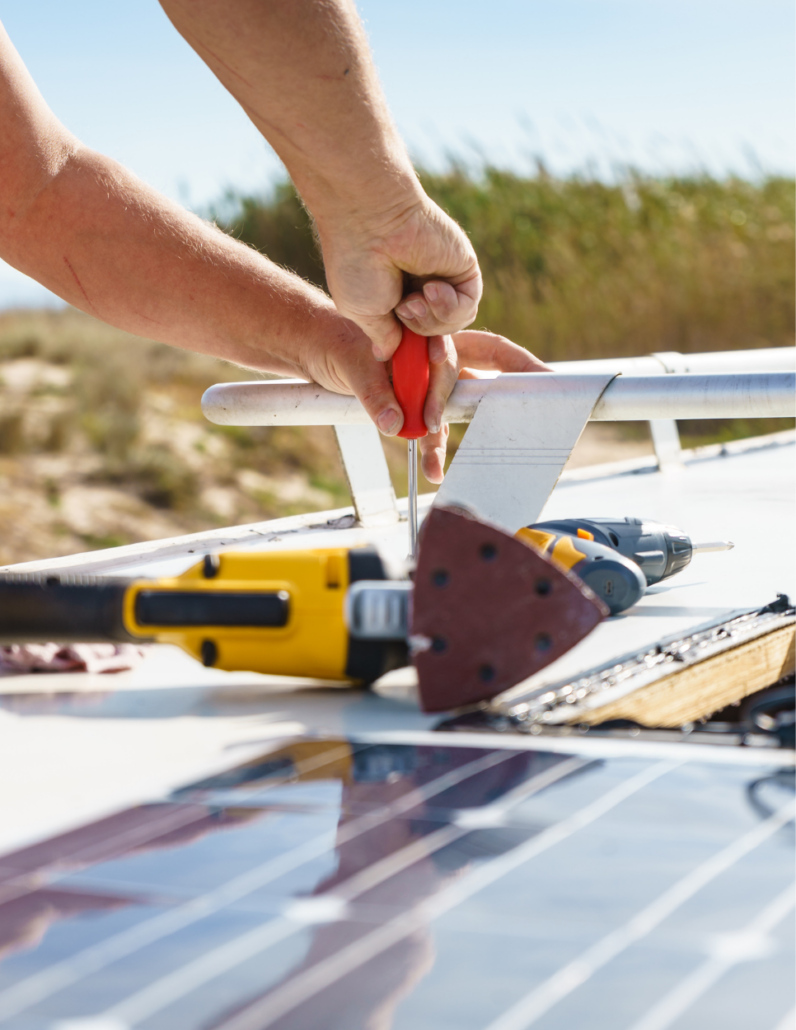Last Updated on July 25, 2023 by Mary Pressler
DIY Solar Power Systems: Recommendations, Pros and Cons
Solar power has become the fastest growing electricity source in the US, representing 50% of all generation capacity installed in 2021. The country now has more than 126 gigawatts (GW) of photovoltaic capacity, according to the SEIA Solar Market Insight, enough to cover the electricity needs of 22 million homes. Many solar companies specialize in residential installations, and you can get professional workmanship and long-term warranties by choosing carefully.
Maybe you’re considering a DIY solar power system instead?
Like in any technical decision, this approach has pros and cons. Compared with a professional installation, a DIY solar system normally has a much lower cost. However, the first step is being aware that electricity is dangerous regardless of the source. When dealing with high voltages and power ratings, clean power is just as dangerous as fossil fuel power.
- For safety purposes, the best recommendation is purchasing a solar panel kit specifically designed for DIY projects.
- These systems work with lower voltages and wattages, compared with the larger PV modules used in rooftop installations.
If you plan to use a DIY solar system, another recommendation is to keep your project off the grid. Most of the solar PV systems you see on rooftops are grid-tied: they are synchronized with the local grid voltage and frequency, and homeowners can use electricity from both sources without switching manually. Unfortunately, you need permission from your power company to connect solar panels to their voltage supply, and they only accept professional installations. Unless you’re a licensed electrician, your DIY solar project will be forced to stay off-grid.
Grid-Tied vs Off-Grid Solar Power: Main Differences
As mentioned above, a DIY solar system will most likely be off-grid, since electric utility companies only allow professional grid-tied installations. Many grid-tied solar systems use strings of PV modules connected to an inverter, which in turn synchronizes with the grid. An off-grid installation needs two additional devices to provide a stable voltage supply: a charge controller and a battery.
DIY solar kits often include all-in-one power stations. These units have all three components built-in: charge controller, battery bank and inverter. These portable power stations also include AC outlets and USB ports, so you can connect small appliances and mobile devices directly. You only need to make sure that the devices plugged in don’t exceed the rated power output of your off-grid solar system.
Purchasing all components separately and wiring them together is also an option, but you need to make sure you have the right type of cable.
- Adaptor Kit: Connects the solar panels and the charge controller.
- Tray cable: Connects the charge controller and the battery bank.
- Inverter cable: Connects the battery bank and the inverter.
The main drawback of a DIY solar project is limiting your options. Generally, the top solar brands only sell their products through authorized installers, not directly to the public. Even if you can purchase rooftop solar panels directly, and you manage to wire them correctly, their warranty will most likely be voided.
DIY solar kits also come with warranties, and they will remain valid as long as you follow the instructions provided. However, these warranties are much shorter than those offered with professionally installed solar panels.
Our Recommendations for DIY Solar Projects
Most solar panels are based on the same physical principle: they use a photovoltaic material that generates voltage and current when exposed to a light source. This means solar panels also work with artificial lighting, but in this case the electricity consumed is more than the electricity produced. When using sunlight, on the other hand, PV cells can convert a free input into a valuable output.
The solar panels you see on rooftops are larger and heavier than they seem from the ground.
- Generally, a 60-cell residential panel will have dimensions of around 65” x 40” (5.4’ x 3.3’), and a weight of around 35 – 50 pounds.
- Handling PV modules while standing on a roof can be very dangerous for someone who hasn’t been trained as a solar installer.
Solar panels can also reach high voltages when many of them are wired together. For example, if you have a string of 15 solar panels operating at 40V each, the total circuit voltage is 600V. When DC voltages of these magnitudes are involved, there is no room for error.
You can find smaller solar panels that are a much better option for DIY projects. Thanks to their lower weight and voltage output, they are a much safer option than the traditional PV modules used in rooftop installations. If you’re looking for small solar panels that are suitable for DIY projects, Quick Electricity recommends A1 Solar Store.
These brands manufacture solar kits that are lightweight and portable, and their electrical connections are safe and user-friendly. However, you should still read their instruction manuals carefully to ensure adequate wiring and operation. The wattages and voltages involved are lower than in a rooftop installation, but you should exercise caution like with any electrical device.


Leave a Reply
Want to join the discussion?Feel free to contribute!